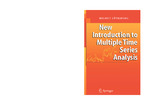New Introduction to Multiple Time Series Analysis
Abstract
When I worked on my Introduction to Multiple Time Series Analysis (Lu¨tkepohl
(1991)), a suitable textbook for this field was not available. Given the
great importance these methods have gained in applied econometric work, it
is perhaps not surprising in retrospect that the book was quite successful.
Now, almost one and a half decades later the field has undergone substantial
development and, therefore, the book does not cover all topics of my own
courses on the subject anymore. Therefore, I started to think about a serious
revision of the book when I moved to the European University Institute in
Florence in 2002. Here in the lovely hills of Toscany I had the time to think
about bigger projects again and decided to prepare a substantial revision of
my previous book. Because the label Second Edition was already used for a
previous reprint of the book, I decided to modify the title and thereby hope
to signal to potential readers that significant changes have been made relative
to my previous multiple time series book.
Although Chapters 1–5 still contain an introduction to the vector autoregressive
(VAR) methodology and their structure is largely the same as in
Lu¨tkepohl (1991), there have been some adjustments and additions, partly
in response to feedback from students and colleagues. In particular, some
discussion on multi-step causality and also bootstrap inference for impulse
responses has been added. Moreover, the LM test for residual autocorrelation
is now presented in addition to the portmanteau test and Chow tests for
structural change are discussed on top of the previously considered prediction
tests. When I wrote my first book on multiple time series, the cointegration
revolution had just started. Hence, only one chapter was devoted to the topic.
By now the related models and methods have become far more important for
applied econometric work than, for example, vector autoregressive moving average
(VARMA) models. Therefore, Part II (Chapters 6–8) is now entirely devoted
to VAR models with cointegrated variables. The basic framework in this
new part is the vector error correction model (VECM). Chapter 9 is also new.
It contains a discussion of structural vector autoregressive and vector error
correction models which are by now also standard tools in applied econometric analysis.

